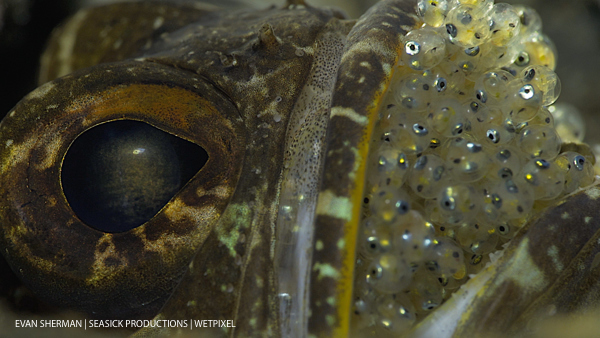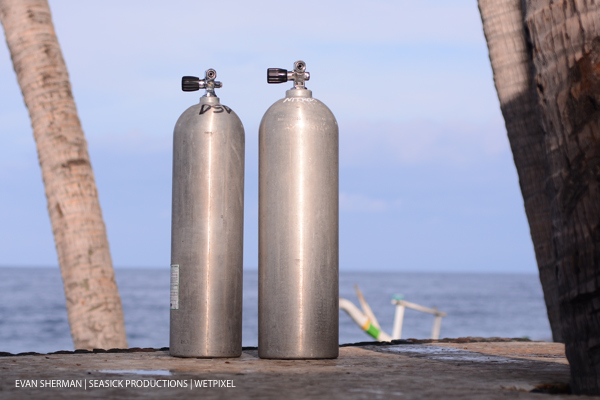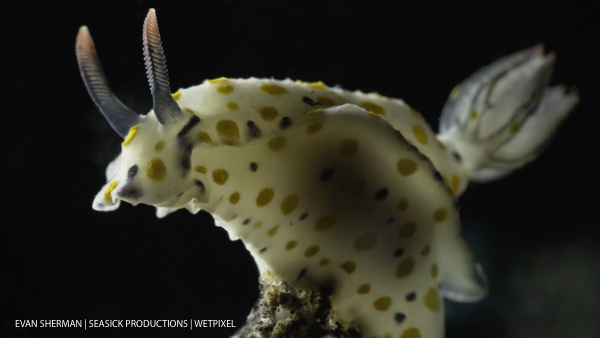Freeze Frame: The Power of a Bigger Tank
The Power of a Bigger Tank When On the Road
By Evan Sherman
So there I was, at the manta cleaning station in Yap, about to complete the minute 80 of the dive when finally the stars of the show arrived. It had been a true test of patience as one can only stare off into empty blue water or watch Cleaner Wrasse scurry about for so long. By the time the mantas blessed us with their presence, the original group of ten divers had dwindled down to only three. Some got cold. A couple got bored. However, most had run low on air. I, on the other hand had plenty of air remaining because of my “secret weapon”…a 100 cubic foot (15 liter) tank.

Higher capacity tanks are nothing new as many divers utilize them in their local waters. Some of these same people even use twin tanks or “doubles.” So why is that most (and I do mean most) people settle for a standard 80 cubic foot (11.1 liter) tank when they travel? It’s no surprise, more air in a bigger tank allows more time to safely do what we do: Capture images. What is surprising: the availability of bigger tanks at dive resorts and liveaboards around the world and how little they are utilized.

The first and most obvious benefit of a bigger tank: I almost never run low on air. Typically I run out of allowable no deco time long before my tank runs low. My nitrogen build-up is often the determining factor when having to end a dive. Not a full SD card, dead camera battery or empty tank. Second, knowing I started with a surplus of air puts me at ease. I don’t have to be hyper vigilant about my air consumption. I still check my gauges frequently and I am aware of my remaining bottom time, but I know in the back of my mind that I have that buffer. This allows me to focus better on the task at hand: Taking underwater images.

Granted, a larger aluminum tank has more out-of-water weight. It has more mass underwater and when depleted, is more positively buoyant than a regular aluminum 80 tank. These drawbacks are out weighed (no pun intended) by the benefits. Some dive operators charge a couple bucks more for the larger tank, but c’mon, we just spent how much money for this dive trip? A larger tank may not be for everyone but for photographers and videographers this is an excellent advantage when attempting to capture high quality underwater imagery. Professional level images require more time and more focus. It is a never-ending process of overcoming obstacles such as limited air supply, nitrogen build-up, adequate media storage, limited battery life–the list goes on and on. Fortunately, many of these restraints are easy to address. For example, using larger memory cards, increased milliampere hour batteries and diving nitrox are easy solutions. So is getting a bigger tank.
Just a thought.
About the author:
Evan Sherman is the owner of Seasick Productions, a full-service multimedia company that specializes in underwater imaging. Based out of Orange County, California, Seasick Productions provides on location and studio production services around the world. From Evan’s first dive with a camera, he fell in love with underwater videography. His second dive with a camera, he flooded it. He was 19 and had already learned a critical lesson about life as a professional underwater cameraman: passion fuels the artist, tools allow the artist to be. Evan later received his B.A. in Film and Electronic Media from California State University Long Beach. Evan’s professional underwater credits include television networks, Fortune 500 companies and numerous entities within the dive industry.
Evan’s recent film, Bali Close Up, earned top honors at the World ShootOut Underwater Photo Grand Prix in Germany, Video of the Year at the ADEX Voice of the Ocean Competition in Singapore, the Best of Show and Stan Waterman Legacy Award at the Turquoise Bay International Underwater Film Festival in Roatan, and Silver at the Our World Underwater Video Competition. He is a contributor for DivePhotoGuide, Wetpixel and is a SEA&SEA Alpha, ambassador for their products. Throughout the year Evan conducts dive expeditions and imaging workshops.